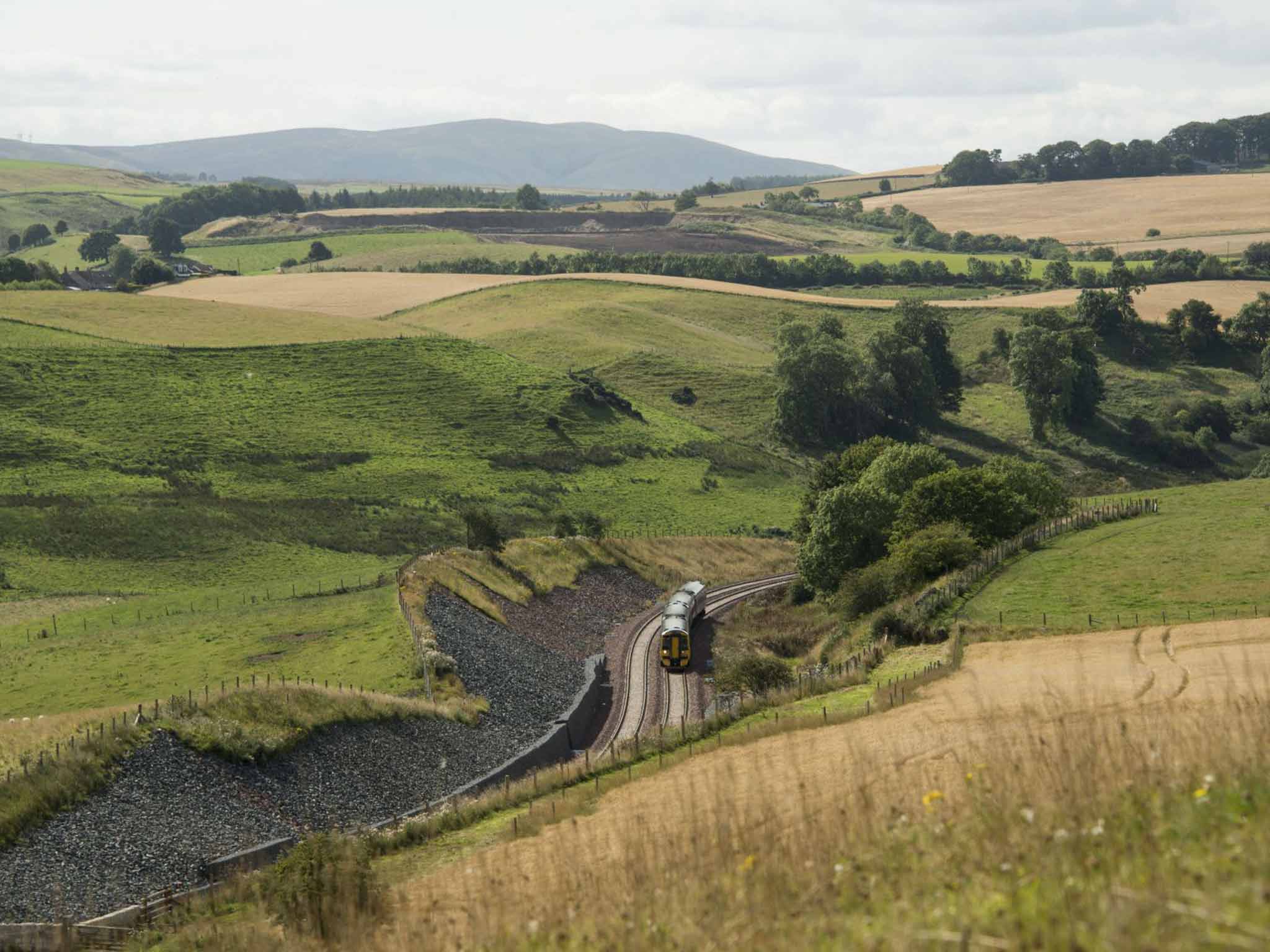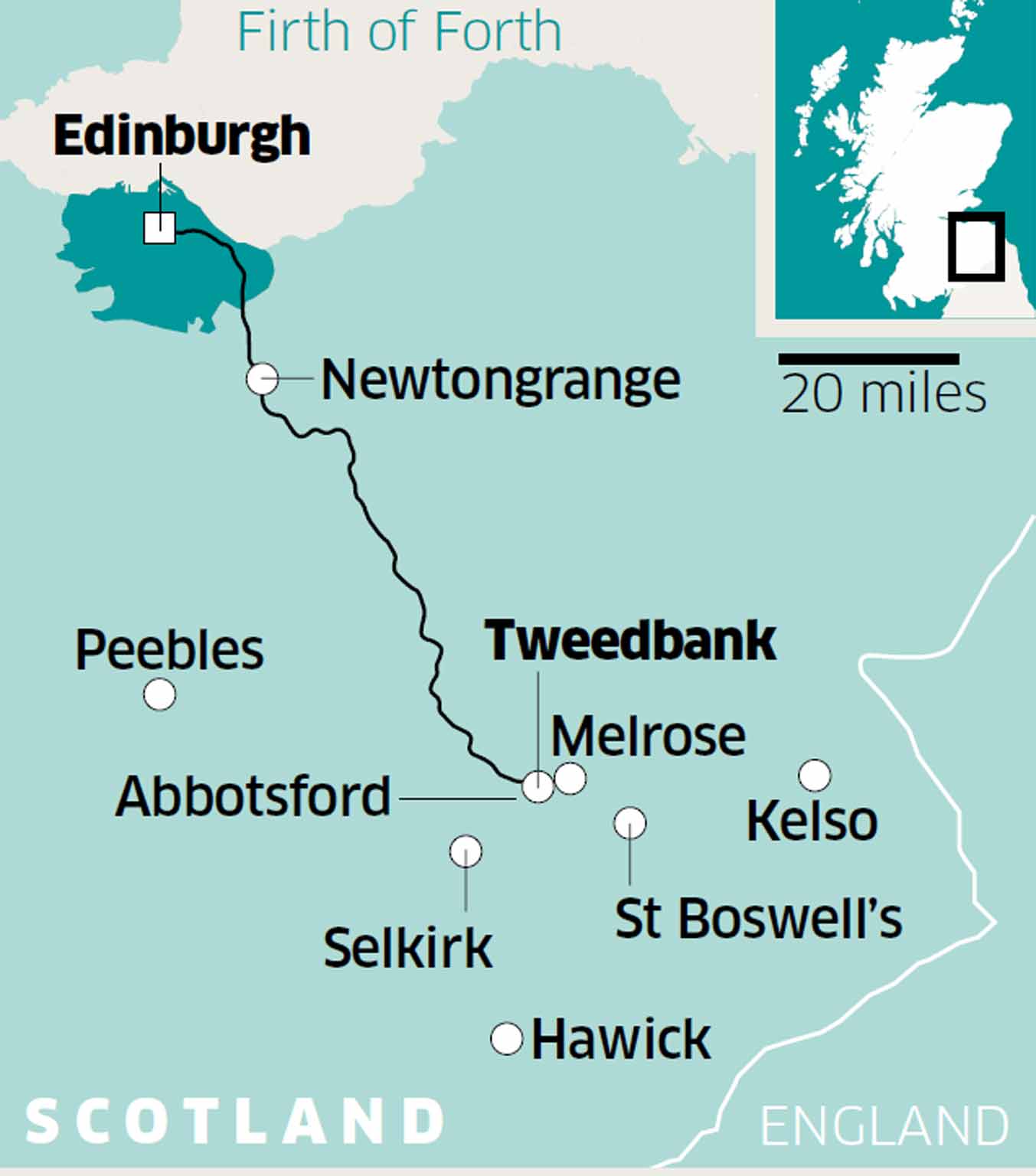Scottish Borders railway brings a historic region back into focus
Britain's first new domestic railway to be built for more than 100 years opened last week. Michael Williams reports

Your support helps us to tell the story
This election is still a dead heat, according to most polls. In a fight with such wafer-thin margins, we need reporters on the ground talking to the people Trump and Harris are courting. Your support allows us to keep sending journalists to the story.
The Independent is trusted by 27 million Americans from across the entire political spectrum every month. Unlike many other quality news outlets, we choose not to lock you out of our reporting and analysis with paywalls. But quality journalism must still be paid for.
Help us keep bring these critical stories to light. Your support makes all the difference.
It's a fantasy more exotic than anything dreamt up by Sir Walter Scott – Scotland's most famous novelist, whose "Waverley" tales once gripped the imagination of the world with their ghosts, goblins, romantic abbeys, ruinous castles, and other things that go bump in the night.
Here I am, waking amid expanses of crisp, starched sheets in a four-poster bed in Scott's exotic, baronial home at Abbotsford in the Scottish Borders. The armour of long dead knights creaks along corridors lined with leather-bound books that shade into the oak-panelled recesses of the house, still haunted by the portraits of long-departed ancestors.
An owl hoots mournfully in the trees outside. But I am snug, and who is worrying? An antiquated lever operated by air pressure is there to summon a lavish Victorian breakfast from below stairs, as the sensuous autumn morning fragrance from the phlox and the hebes in the walled gardens drifts into the room.
And along the valley below I can hear the early morning rattle of the trains that bore me here last night from Edinburgh – just an hour away, where little steam engines once puffed along bearing the quaint names of characters from the Waverley novels such as Wizard of the Moor and Wandering Willie.
Hold on a minute. Didn't the trains cease running half a century ago? Wasn't the house left inhabited after Sir Walter's last descendant died? But my sybaritic sojourn at Abbotsford is no reverie. This week the Scottish Borders have been awakened from a long slumber as the first new domestic railway in Britain built for more than a century opened from Edinburgh's Waverley station, extending 30 miles deep into the Scottish Borders.
Here are 1,800 square miles of rolling hills, sparkling rivers and lush forests between Edinburgh and England – perhaps the least explored area of outstanding beauty in Britain. And, miraculously I came here by train, just as I might have done a century ago, to stay in one of the most magnificent and least known country houses in the land, freshly restored at a cost of £12m, now open for overnight guests to share the lavish style of Scotland's famous literary son.
But back in the real world – arriving at the austere new terminus in Tweedbank on the inaugural train last Saturday – the service was not exactly in the style of Sir Walter's day, where there would be a roaring fire in the waiting room, and porters and coachmen would busy about to take the luggage up to the Big House at Abbotsford.
A modest three-car diesel train of 1990s vintage, adorned with some tartan trimmings, is turned out to do the job. (Though for the next few weeks, steam trains, hauled by one of the world speed record-breaking "Mallard" class, will add a touch of glamour to the line.) Meanwhile the old station at Melrose – where the guard would once shout: "Alight for Abbotsford" – still stands intact but in sad isolation, shaken by the heavy lorries that run alongside on the A7 trunk road, built through the platforms after the old railway closed. Sadly it was deemed too costly to bring back into use.
But who could diminish the bravura of rebuilding this, the most mourned of Britain's great railways? Shut cruelly on the recommendation of the infamous Dr Beeching in 1969, after 107 years, the 98-mile "Waverley" line between Edinburgh and Carlisle was the longest and most scenic UK railway ever to be closed. Its demise devastated an entire region.
For many this was not just a railway, but also a symbol of the greatness, passion and romance of the Border Country, with its massive castles, grand estates, and romantic ruined abbeys, and a world-famous wool and textile industry. The landscape is scored with the centuries-long history of conflict between two nations.
Half a century ago, not even the most optimistic dreamer could have imagined that a modern state-of the art railway would rise from the ashes of the Waverley route. Built on time and for a cost of £350m – a pinprick compared with the projected £50bn cost of HS2 (though that will be more than four times longer) – it is the culmination of a vision by the Scottish government, which has shamed its Westminster counterpart in its record of bringing old railways back to life. When the Borders Railway opened to the public last weekend, a grand total of 93,000 sleepers had been laid, more than 800,000 tons of earth moved, and at least two million man hours had been spent on the reconstruction – not to mention the 25,000 bacon rolls consumed by the construction team.
So fastidious were the engineers that they gently scooped precious, rare lampreys out of the local river and transported them carefully to a new home so the trains would not disturb them. But this has been more than just a feat of civil engineering. Like the lost worlds depicted in the Waverley novels, the new railway opens a door into a land that time forgot. The new terminus at Tweedbank becomes a gateway to a more authentic Scotland that has remained so, paradoxically, because it has been deprived of transport links for so long.
Here are delightful small restaurants and pubs sourcing local foods, where salmon plucked from the Tweed and local game are king. Little towns with proud stone-fronted high streets are alive with local businesses. Melrose, Kelso, St Boswell's, Selkirk, and Peebles are all gently awakening with the buzz surrounding arrival of the new railway.
Over lunch of "lightly smoked pigeon, locally shot, with pickled nasturtium seeds" and "salmon, cured with North Berwick gin" at the Chapters restaurant in Melrose I couldn't be further from the clichés of Irn Bru and deep fried Mars Bars. Roger McKie, who cooks and runs it with his wife Bea, enthuses that the long slumber of the Borders means it is capturing a new generation of tourists, more interested in regional identity then identikit Scottishness. (Though there's plenty of the traditional Scotland here for those with a taste for it. The heart of Robert the Bruce is said to be buried nearby at Melrose Abbey, where one of the attractions is a carving of a pig playing the bagpipes.)
There's more tradition along the road at Kelso, where the fairytale Floors Castle, the largest inhabited castle in Scotland, designed by William Adam in 1721, is still occupied by the descendants of the original owners, the Earls of Roxburghe. Visitors are permitted to linger amid the intimacy of the family living quarters, where snaps of the present Duke and his children jostle with priceless portraits and tapestries from past eras.
When I drop by, I am told that His Grace – Sir Guy David Innes Ker, 10th Duke and Earl of Roxburghe – is out with a shooting party, and the staff are busy clearing the table from the grand breakfast that preceded it. Still, I am presented with a jar of the estate's homemade marmalade to take home as a souvenir.
There's a different narrative of Scottish history at Newtongrange station, where the former Lady Victoria Colliery, the most complete surviving coal mine in Europe, has been transformed into the National Museum of Mining. Amid the rusting pithead gear, Jim Cornwall, who worked at the colliery, like his father and grandfather before him, until it closed in 1981, recalls stories about the old times.
He's optimistic about how the new railway will transform visitor numbers. "When Maggie [Thatcher] felled us, the community was devastated, but now the train means we're going to get a new generation coming along." One day, he hopes, the cash flow may even get the 90-year-old winding engine back into steam again.
But some niggles remain. Anyone expecting a return to the charm of the country railways of old will be disappointed, with spartan unstaffed stations whose brutalist architecture is better to suited to platforms serving a Glasgow housing estate. No elegant wrought iron or elaborate architraves here. There are mutterings, too about the lack of capacity for trains to pass each other along the single track – although by rural standards the timetable is enviable, with trains on the hour-long journey every 30 minutes up to midnight.
But public transport onwards from the Tweedbank terminus is still primitive. Passengers seeking to pursue the old Waverley route, through towns between here and Carlisle, such as Hawick and Langholm, will face a stomach-churning journey along the twisty A7 aboard the X95 bus, which takes two hours to complete the rest of the journey.

Yet nowhere else in Britain is a railway so rooted in the hearts and minds of the local people. As my inaugural train pulled into Tweedbank a big man in a high-vis jacket was blinking away the tears – and it is easy to see why. The rebuilding of the railway is seen locally as an almost moral issue. "We're putting right a long-standing wrong done to the Borders by people in high places," he tells me.
And who knows? If the line is a success, maybe the tracks will push on one day over the Eildon Hills and through Teviotdale into the even more sensationally beautiful countryside that runs up to the Border itself.
The cost would be at least another £500m. But there are many who dare to hope. If it happens, none would be more grateful than the shadows of Rob Roy, Jeanie Deans, Redgauntlet and the other fantastic creations of Walter Scott's imagination, as their legacy is dusted off to work its magic even wider.
Michael Williams's story of the building of "The Line that Rose from the Dead" is in his new book The Trains Now Departed: Sixteen Excursions into the Lost Delights of Britain's Railways (Preface, £20)
Getting there
The Borders Railway runs between Edinburgh and Tweedbank (bordersrailway.co.uk; nationalrail.co.uk).
Staying there
Abbotsford, Melrose, Roxburghshire TD6 9BQ (01896 752043; scottsabbotsford.com). Double rooms start at £120, including breakfast. Self-catering stays from £1,500 for a three-night break for up to 10 guests.
More information
Join our commenting forum
Join thought-provoking conversations, follow other Independent readers and see their replies
Comments